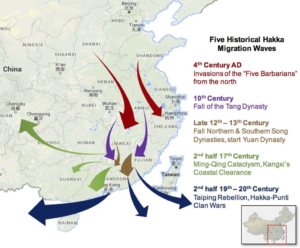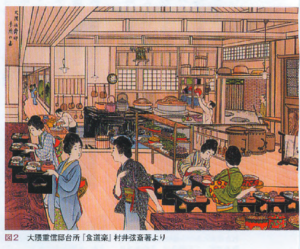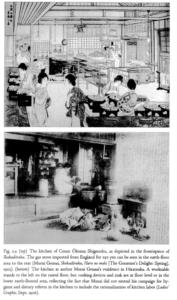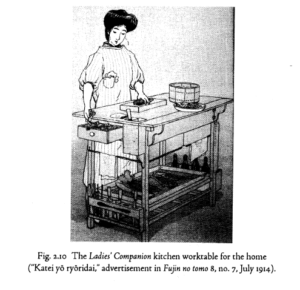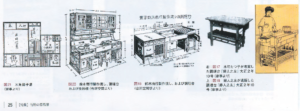“If the door speaks where the wall is mute, the bridge speaks louder than both. It is more prone to symbolization.” –Harrison[1]
In his essay on the “Bridge and Door”, Simmel argues that bridges, roads, doors and windows all perform the function of both connecting spaces and keeping them separate.[2] Of these, the bridge, in its ability to contain multitudes of meanings and functions, is the most symbolically rich. Inspired by Simmel’s writings, Harrison argues that not only does a bridge connect a ‘place of origin to a destination’, as a road does; but that a bridge is even more psychologically impressive- it emphasizes human victory over nature, space and time.[3] Harrison writes about bridges as spaces of living and of commerce; of execution, suicide and war; as transitional spaces, and also as ‘third spaces of union’.[4] Because of its liminality, Harrison argues, the bridge makes it impossible to ‘achieve the appurtenances of social identity’ – in other words, the identity one creates on a bridge is only ever transient, temporary.[5]
However, the opposite can be seen in the example of Hong Kong’s Little Manila. Little Manila is a social gathering that appears every Sunday, spanning a large area beneath the arches and in the overhead walkways of Norman Foster’s HSBC building, as well as in Statue Square and Chater Garden.[6] Just like the bridges discussed in Harrison’s chapter, Little Manila transforms the office buildings, walkways, and squares it occupies into spaces of separation, and of difference between the office workers who use the space during the week, and the domestic workers who occupy it on Sundays. As seen from Tomas Laurenzo’s photograph, the cardboard walls and the blankets that transform the walkway from a transient space to one filled with activity are only temporary. However, Little Manila also represents a wish for transition and bridging, for creating a more permanent identity of the migrant domestic worker from the Philippines in Hong Kong.
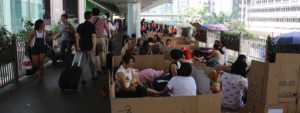
Photo by Tomás Laurenzo. Taken from: Laurenzo, Tomás. “Foreign Helpers.” Tomás Laurenzo: New Media Art & Research (blog), 2015. https://laurenzo.net/foreign-helpers.
Daisy Tam summarizes that from the 1970s onwards, when Hong Kong shifted from an industry based economy to one that was service based, the demand for domestic workers increased.[7] As of 2016, the time of Tam’s article publication, 300,000 migrant workers from the Philippines worked in Hong Kong as domestic helpers.[8] As Tam argues, Little Manila represents a space of resistance where Filipina women can re-appropriate the very architecture that represents the capitalist system by which they are oppressed.[9]
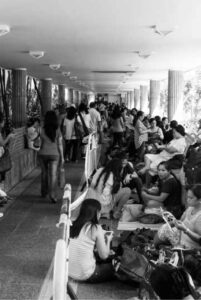
Photo by Daisy Tam. Taken from: Daisy Tam, “Little Manila: The Other Central of Hong Kong,” in Messy Urbanism: Understanding the “Other” Cities of Asia, by Manish Chalana (Hong Kong: Hong Kong University Press, 2016), 127.
Little Manila becomes a space where women can reinforce their Philippine identities through sharing conversation, food, magazines, and time, as seen in the photo above. These identities are not liminal, even if the space they are practiced in is temporary, occurring only every Sunday. In creating this space of resistance, the women who use the space in this way also create a bridge. Little Manila becomes a third space: not Manila, not Hong Kong. Though it spans various types of physical spaces, from walkways to squares, Little Manila in itself becomes a bridge –a symbol of Philippine identity in Hong Kong.
Bibliography
Harrison, Thomas. 2021. Of Bridges: A Poetic and Philosophical Account. Chicago: The University of Chicago Press.
Laurenzo, Tomás. “Foreign Helpers.” Tomás Laurenzo: New Media Art & Research (blog), 2015. https://laurenzo.net/foreign-helpers.
Simmel, Georg, David Frisby, and Mike Featherstone. 1997. Simmel on Culture: Selected Writings. California: SAGE.
Tam, Daisy. 2016. “Little Manila: The Other Central of Hong Kong.” In Messy Urbanism: Understanding the “Other” Cities of Asia, by Manish Chalana. Hong Kong: Hong Kong University Press.
[1] Thomas Harrison, Of Bridges: A Poetic and Philosophical Account (Chicago: The University of Chicago Press, 2021), 7.
[2] Georg Simmel, David Frisby, and Mike Featherstone, Simmel on Culture: Selected Writings (California: SAGE, 1997), 171.
[3] Harrison, Of Bridges, 5.
[4] Ibid, 1.
[5] Ibid, 58.
[6] Daisy Tam, “Little Manila: The Other Central of Hong Kong,” in Messy Urbanism: Understanding the “Other” Cities of Asia, by Manish Chalana (Hong Kong: Hong Kong University Press, 2016), 1.
[7] Ibid, 119.
[8] Ibid.
[9] Ibid, 124.
